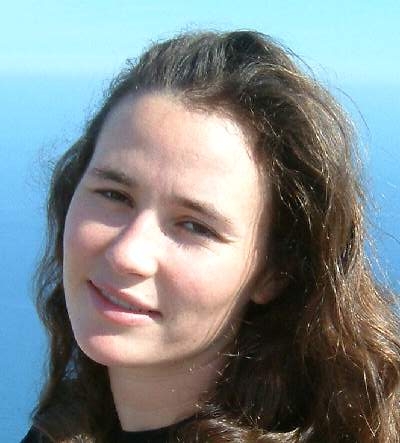|
|
Caroline Lacoste
Ancien Doctorant
 Mots-clés : Géométrie stochastique, MCMC, Extraction d'objets, Lineique, Routes Mots-clés : Géométrie stochastique, MCMC, Extraction d'objets, Lineique, Routes
 Démo : voir la démo de l'auteur Démo : voir la démo de l'auteur
 Contact : Contact :
|

|  Dernières publications dans le projet Ariana : Dernières publications dans le projet Ariana :
Unsupervised line network extraction in remote sensing using a polyline process.
C. Lacoste et X. Descombes et J. Zerubia. Pattern Recognition, 43(4): pages 1631-1641, avril 2010.
Mots-clés : Processus ponctuels marques, Reseaux lineiques, Road network extraction.
@ARTICLE{lacoste10,
|
| author |
= |
{Lacoste, C. and Descombes, X. and Zerubia, J.}, |
| title |
= |
{Unsupervised line network extraction in remote sensing using a polyline process}, |
| year |
= |
{2010}, |
| month |
= |
{avril}, |
| journal |
= |
{Pattern Recognition}, |
| volume |
= |
{43}, |
| number |
= |
{4}, |
| pages |
= |
{1631-1641}, |
| url |
= |
{http://dx.doi.org/10.1016/j.patcog.2009.11.003}, |
| keyword |
= |
{Processus ponctuels marques, Reseaux lineiques, Road network extraction} |
| } |
Abstract :
Marked point processes provide a rigorous framework to describe a scene by an unordered set of objects. The efficiency of this modeling has been shown on line network extraction with models manipulating interacting segments. In this paper, we extend this previous modeling to polylines composed of an unknown number of segments. Optimization is done via simulated annealing using a Reversible Jump Markov Chain Monte Carlo (RJMCMC) algorithm. We accelerate the convergence of the algorithm by using appropriate proposal kernels. Results on aerial and satellite images show that this new model outperforms the previous one. |
Point Processes for Unsupervised Line Network Extraction in Remote Sensing.
C. Lacoste et X. Descombes et J. Zerubia. IEEE Trans. Pattern Analysis and Machine Intelligence, 27(10): pages 1568-1579, octobre 2005.
@ARTICLE{lacoste05,
|
| author |
= |
{Lacoste, C. and Descombes, X. and Zerubia, J.}, |
| title |
= |
{Point Processes for Unsupervised Line Network Extraction in Remote Sensing}, |
| year |
= |
{2005}, |
| month |
= |
{octobre}, |
| journal |
= |
{IEEE Trans. Pattern Analysis and Machine Intelligence}, |
| volume |
= |
{27}, |
| number |
= |
{10}, |
| pages |
= |
{1568-1579}, |
| pdf |
= |
{http://ieeexplore.ieee.org/xpls/abs_all.jsp?isnumber=32189&arnumber=1498752&count=18&index=4}, |
| keyword |
= |
{} |
| } |
A Polyline Process for Unsupervised Line Network Extraction in Remote Sensing.
C. Lacoste et X. Descombes et J. Zerubia. Rapport de Recherche 5698, INRIA, France, septembre 2005.
@TECHREPORT{rrCaroline,
|
| author |
= |
{Lacoste, C. and Descombes, X. and Zerubia, J.}, |
| title |
= |
{A Polyline Process for Unsupervised Line Network Extraction in Remote Sensing}, |
| year |
= |
{2005}, |
| month |
= |
{septembre}, |
| institution |
= |
{INRIA}, |
| type |
= |
{Research Report}, |
| number |
= |
{5698}, |
| address |
= |
{France}, |
| url |
= |
{http://hal.inria.fr/inria-00070317}, |
| pdf |
= |
{http://hal.inria.fr/docs/00/07/03/17/PDF/RR-5698.pdf}, |
| ps |
= |
{http://hal.inria.fr/docs/00/07/03/17/PS/RR-5698.ps}, |
| keyword |
= |
{} |
| } |
Résumé :
Ce rapport présente un nouveau modèle issu de la géométrie stochastique pour l'extraction non supervisée de réseaux linéiques (routes, rivières, etc.) à partir d'images satellitaires ou aériennes. Le réseau linéique présent dans la scène observée est modélisé par un processus de lignes brisées, appelé CAROLINE. Le modèle a priori incorpore de fortes contraintes géométriques et topologiques au travers de potentiels sur la forme des lignes brisées et de potentiels d'interaction. Les propriétés radiométriques sont incorporées via la construction d'un terme d'attache aux données fondé sur des tests statistiques. Un recuit simulé sur un algorithme de type Monte Carlo par Chaîne de Markov (MCMC) à sauts réversibles permet une optimisation globale sur l'espace des configurations d'objets, indépendamment de l'initialisation. L'ajout de perturbations pertinentes permet une accélération de la convergence de l'algorithme. Des résultats expérimentaux obtenus sur des images satellitaires et aériennes sont présentés et comparés à ceux obtenus avec un précédent modèle fondé sur un processus de segments, appelé Quality Candy. |
Abstract :
This report presents a new stochastic geometry model for unsupervised extraction of line networks (roads, rivers, etc.) from remotely sensed images. The line network in the observed scene is modeled by a polyline process, named CAROLINE. The prior model incorporates strong geometrical and topological constraints through potentials on the polyline shape and interaction potentials. Data properties are taken into account through a data term based on statistical tests. Optimization is done via a simulated annealing scheme using a Reversible Jump Markov Chain Monte Carlo (RJMCMC) algorithm, without any specific initialization. We accelerate the convergence of the algorithm by using appropriate proposal kernels. Experimental results are provided on aerial and satellite images and compared with the results obtained with a previous model, that is a segment process called Quality Candy. |
|
 Liste complète des publications dans le projet Ariana
Liste complète des publications dans le projet Ariana
|
|


